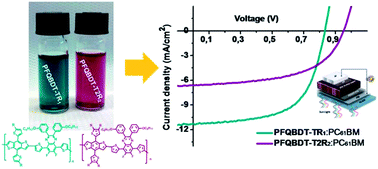Structural tuning of quinoxaline-benzodithiophene copolymers via alkyl side chain manipulation: synthesis, characterization and photovoltaic properties†
Abstract
We report here the synthesis and characterization of two novel semiconducting quinoxaline (FQ)-benzodithiophene (BDT) based copolymers, PFQBDT-TR1 and PFQBDT-T2R2, in which the BDT unit is substituted with either 2-octylthienyl (-TR1) or 2,3-dihexylthienyl (-T2R2), respectively, as side groups. The effect of the alkyl side chain(s), linked to the thienyl side groups, on the optical, electronic and morphological properties of the resulting polymers is investigated and correlated with the photovoltaic performance. Solution-processed BHJ solar cells, using these copolymers as electron donor materials and PC61BM (or PC71BM) as an electron acceptor counterpart, are prepared by a blade-coating technique under ambient conditions. As a result, power conversion efficiencies (PCEs) of ∼5.7% and ∼3.4% have been achieved for PFQBDT-TR1 and PFQBDT-T2R2 based devices, respectively, highlighting the crucial role of the alkyl portion of the π-conjugated side segment in the optoelectronic properties of this class of copolymers.


 Please wait while we load your content...
Please wait while we load your content...